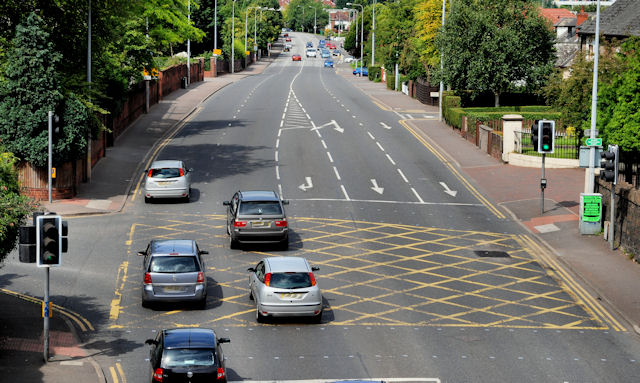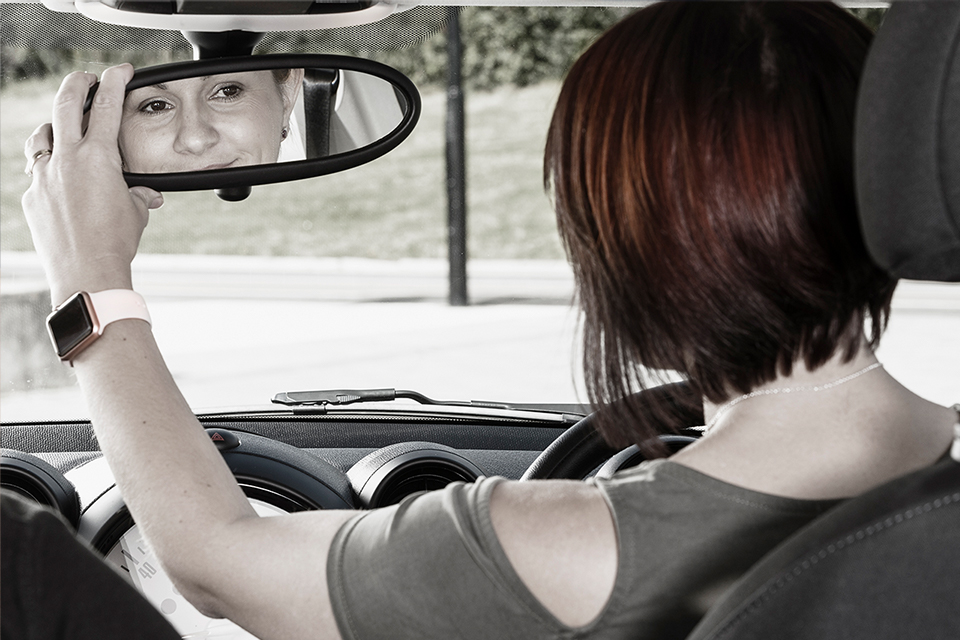If learning to drive wasn’t complicated enough for you, the driving test will certainly take the cake. No stone, or rather, road type, is left unturned during the practical.
Driving examiners will use everything at their disposal to ensure you’re well and truly put though your paces. (Who said becoming a fully qualified driver would be easy?!). Some of the trickiest parts of your test route will be junctions.
If you’re looking to pass with flying colours, then it’s important you know how to deal with junctions properly. We’re going to walk you through the different types of junctions that you’re likely encounter on your test, how to recognise them and how to approach them safely.
Road junctions

Photo © Albert Bridge (cc-by-sa/2.0)
As any learner worth their salt knows, nothing is ever quite as simple as it should be when it comes to driving. Instead of describing a single road feature, ‘junction’ could refer to a variety of road types that join different roads together.
Example junctions—which you may already be familiar with—can be found below!
T-junctions
One of the most common types of junctions out there, T-junctions are when one road meets another in a T-shape (hence the name).
These types of junctions can feature ‘stop’, ‘give way’ or minimum/maximum speed signs. They may or may not feature road markings, depending on their location.
You’ll almost definitely you’ll encounter T-junctions in your practical, with this common road feature occurring on both major and minor roads.
Y-junctions
As with T-junctions, Y-junctions are given their name due to their resemblance to the letter. Y-junctions typically have a major road ahead with a minor road joining at an angle.
Again, depending on the location of the Y-junction, there may or may not be road markings in place to direct road priority.
It’s highly likely that you’ll come across Y-junctions in your practical. You can find them on minor roads, dual carriageways and motorways—the latter of which will not feature on your test.
Crossroads
Crossroads are pretty self-explanatory. It’s essentially when two or more roads cross one another.
Though they might seem simple enough, they can be pretty hazardous if they’re unmarked—so watch out! Stay vigilant even with marked and controlled crossroads.
It’s unlikely that your test route won’t feature crossroads, so swot up! Take special care to look for pedestrians and cyclists.
Staggered junctions
Staggered junctions are very similar to crossroads, except that they’re offset. Typically, a minor road will meet a major road and continue onto a minor road slightly further ahead.
If traffic lights aren’t available, you’ll undoubtedly see ‘give way’ or ‘stop’ signs scattered around the junction.
If a staggered junction crops up on your test, you should take great care with road positioning and signalling.
Roundabouts
Ah, roundabouts. The bane of many a learner’s existence. Though you might not have realised it, roundabouts are a type of junction.
You’ll usually get plenty of advance warning with road signs upon the approach to a roundabout.
If your local area contains a variety of roundabouts, they’re likely to feature in your test.
Ways in which junctions can differ…
Whilst we have already shown you the main types of junctions that you should be familiar with, they’re not always as cut and dry as you’d like. We briefly touched on this in our descriptions when we mentioned road markings. Let’s take a closer look…
Open junctions
The best type of junction that you can get on your test, open junctions are when a driver has a clear and unobstructed view of the road ahead. This means that you should be able to quickly gauge whether the road ahead is clear or not. If it is clear, drivers will be able to simply move down a gear and drive on without having to stop.
Closed junctions
Slightly more difficult to tackle than open junctions, closed junctions give drivers a far more limited view of the road ahead. Whether it’s trees or signposts, a driver will have a more difficult time gauging the volume of traffic on the road ahead. This means that drivers will have to slow down and come to a stop in order to see if it’s clear enough to emerge.
Blind junctions
At the opposite end of the spectrum, blind junctions, as the name suggests, are when a driver has no clear view of the road ahead. These tricky junctions force the driver to come to a stop at the end of the junction, before slowly creeping out bit by bit to determine if it’s clear ahead.
Marked junctions
As you’d probably guess, these junctions have road markings to help the flow of traffic and direct who has priority. Marked junctions will also usually have ‘stop’ and ‘give way’ road signs scattered about. Junctions that are marked tend to be easier to tackle, as they give you clear indications as to where to stop and so on.
Unmarked junctions
If you prefer a bit of chaos in your life, unmarked junctions might be your new favourite type of junction. Unmarked junctions have no visible road markings available. You’ll usually encounter them in quieter or rural areas. If you’re not used to unmarked junctions, they can be tricky. As no-one has priority, it can become a free-for-all situation.
Box junctions
Box junctions feature a yellow box filled with crossed lines. The purpose of this box is to keep traffic moving—vehicles aren’t allowed to enter the box unless the road ahead of them is clear. Though they typically feature traffic lights to direct the flow of traffic, this isn’t always the case. If you’re not too familiar with them, we’d suggest reading up on our guide to box junction rules.
Controlled junctions
Typically found in busier areas, these junctions are controlled by a set of traffic lights. They sometimes feature multiple lanes and a cyclist waiting area just before the lights. In addition to regular traffic lights, there might also be filter lights—keep your eye out for them. If you fail to move off in time during your test, you could end up with a fault for holding up traffic.
How to deal with junctions
If you’re well into your driving lessons by now, you should already know how to deal with junctions. If, however, you’re in need of some additional instruction or a quick confidence boost, we’re going to walk you through the process.
Make sure you spot them
Before you start laughing at us, you should know that plenty of learner drivers end up totting up driving test faults because they only spotted a junction at the last possible second.
Preparation is key when it comes to driving. It’s one of the building blocks of hazard perception after all!
Additionally, if you don’t notice a junction in time, you might end up braking harshly—which would have dire consequences if you have a tailgater—or driving past it. You’ll be able to figure out pretty quickly whether there’s a junction up ahead or not. You’ll either see road signs and markings, or start to notice the traffic in front of you slowing down.
Do your checks
It’s vital that you go through the mirror-signal-manoeuvre (MSM) routine before you even think about moving into a junction. During your driving test, the examiner will have you under a microscope. They’ll be watching you to make sure you show adequate observation skills. So, don’t give them any room to doubt you.
Start by checking your interior mirror to get a quick look at the traffic behind you and then check your left- or right-hand mirror. Once you’re sure there aren’t any potential hazards stopping you from taking action, use your left or right indicator.
Take action
You need to make sure your road positioning is correct as you start to make a move towards the junction. If you’re turning left, you won’t need to move much.
If, on the other hand, you’re turning right, you’ll need to position your vehicle closer to the centre of the road. You’ll also need to be even more careful with your observation, as you’ll be crossing oncoming traffic. If you’re dealing with an open junction and a clear road up ahead, you might be able to get away with moving down to a lower gear before continuing on your way into the road ahead. If you’re dealing with a busy or closed junction, however you’ll need to come to a stop.
Once it’s clear, you can continue on your merry way. If you’re stuck at a blind junction, you’ll need to slowly creep out to see if there’s any traffic approaching.
Do your checks (Again)!
If you though observations were behind you, you’re sadly mistaken. After joining a new road, it’s important that you check your mirrors again. It’s not just vehicles that you have to keep an eye out for—you’ve got to be vigilant in spotting pedestrians and cyclists.
With traffic fast approaching you, you’ll also need to make sure you don’t dilly-dally too long.
What are examiners looking for at junctions?

Believe it or not, the driving test isn’t rocket science. Whilst it is difficult, of course, if you follow your instructor’s advice and your own common sense, you should be able to pass.
Despite popular driving test myths, examiners aren’t trying to fail you on purpose. If you take care to display the skills they’re looking for, you should have no trouble at all. So, what are they looking for when it comes to junctions?
According to the driving test feedback sheet, learner drivers can pick up faults for the following…
Approach speed
If you approach a junction too quickly or slowly, you’re not showing the examiner adequate control of your vehicle. Once you know a junction is ahead, you should start to slow down. If you continue on without reducing your speed, you’ll end up having to slam on your brakes. Even if you can see that the road ahead is clear, you’ll still likely need to move down a gear. Though you might think that driving slowly will show the examiner how careful you are, it will have the opposite effect. Instead, they’ll assume you’re a hesitant driver who doesn’t know what they’re doing.
Observations
Though junctions can be tricky area in general for learners, observations at junctions is by far their biggest kryptonite. In fact, according to reports from the DVLA, it’s been the number one reason for learners failing their practical test for 10 years! If you don’t fancy falling prey to the same mistakes as other learners, make sure you remember your MSM routine. You need to prove to the examiner that you’re aware of how quickly the road can change.
So, look in your mirrors whenever you’re about to take action—paying close attention for cyclists, motorcyclists and pedestrians. If you want ample time to prepare for dealing with a junction, keep an eye out for any road signs or markings that will warn you.
Turning left or right
Road positioning is important when it comes to approaching a junction. If you’re too far to the left when you’re turning right, for example, you could be cutting off cars behind you that intend to turn left. Once you’ve spotted a junction and completed your checks, you need to position your vehicle well before you intend to turn.
Cutting corners
If you’re slow with your steering, or don’t move forward enough into the junction before steering, you could end up touching the pavement. If you actually mount the pavement, you’ll end up with a major fault. The solution to this is to make sure you’re not driving above second gear—you need to be moving slowly enough that your steering can keep up.
